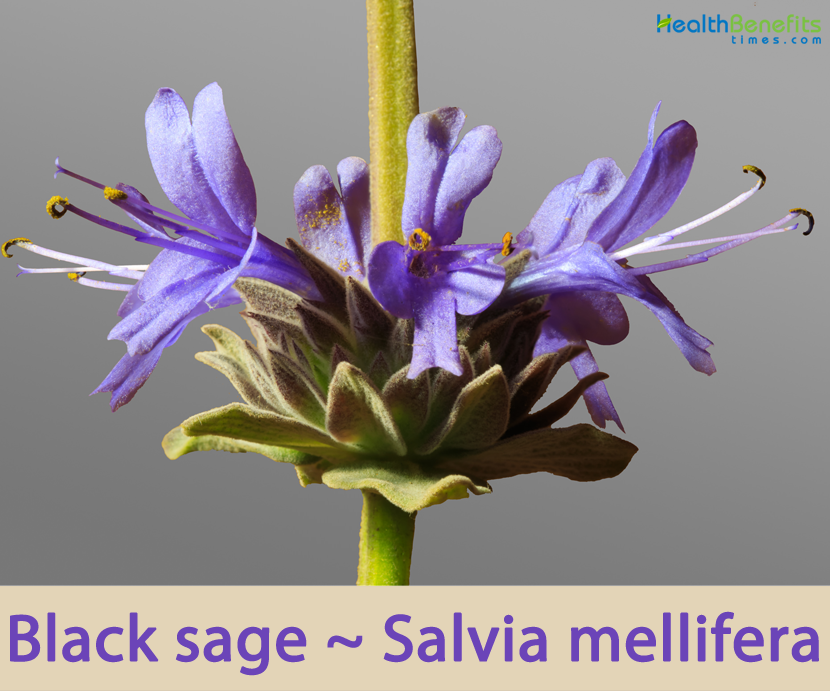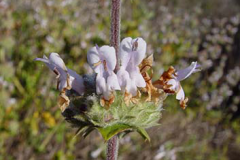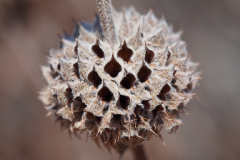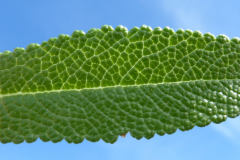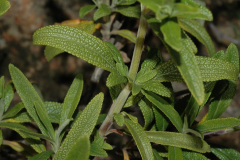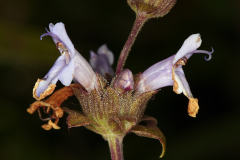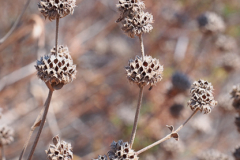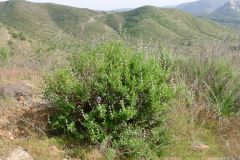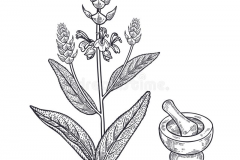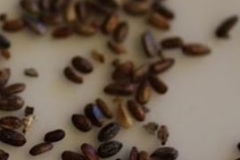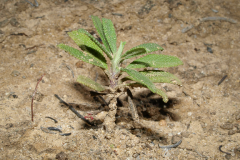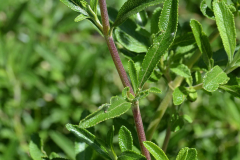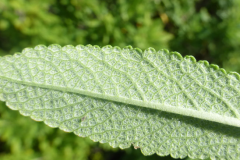The species name mellifera is derived from the Greek melli, which means honey and ferre, which means to bear, thus black sage is “honey-bearing sage.” It is indeed a much sought out nectar source by beekeepers as it produces delicious honey. Black sage has a dark appearance, especially during drought. The plant grows quickly and effectively controls erosion, and is pollinated by native solitary bees, hummingbirds, and butterflies. Black sage readily hybridizes with White Sage, Cleveland Sage, and Purple Sage.
Black Sage Facts
| Black sage Quick Facts | |
|---|---|
| Name: | Black sage |
| Scientific Name: | Salvia mellifera |
| Origin | Coast Ranges of California from Contra Costa and western Stanislaus counties southward into Baja California |
| Colors | Dark brown |
| Shapes | Smooth, dark brown, dehiscent nutlet approximately 0.08 inch (2 mm) long |
| Health benefits | Support sore throats, bronchial coughs, paralysis, flu, rheumatism and arthritis, infections, edema, sore muscles, stiff joints, gingivitis, swollen tongue, bleeding sores, ulcers of the mouth, laryngitis, pharyngitis, and tonsillitis. |
| Name | Black sage |
|---|---|
| Scientific Name | Salvia mellifera |
| Native | Distributed in the Coast Ranges of California from Contra Costa and western Stanislaus counties southward into Baja California. It also occurs on the Channel Islands off the coast of southern California |
| Common Names | Black sage, Honey sage, Californian Black Sage |
| Name in Other Languages | Afrikaans: Swart salie Albanian: Urtë e zezë Amharic: T’ik’uri senigi (ጥቁር ሰንግ) Arabic: Hakim aswad (حكيم أسود) Armenian: Sev maghdz (սև մաղձ) Azerbaijani: Qara adaçayı Bengali: Kālō age si (কালো ageষি) Bulgarian: Cheren gradinski chaĭ (черен градински чай) Burmese: Aanaatraung panyarshi (အနက်ရောင်ပညာရှိ) Chinese: Hēi shǔ wěi cǎo (黑鼠尾草) Croatian: Crna kadulja Czech: Cerný šalvěj, šalvěj černá Danish: Sort salvie Dutch: Zwarte salie English: Black sage, Californian Black Sage Esperanto: Nigra saĝulo Estonian: Must salvei Filipino: Itim na sambong Finnish: Musta salvia French: Sauge noire, audibertie Georgian: Shavi brdzeni (შავი ბრძენი) German: Schwarzer Salbei, Kalifornischer Salbei Greek: Mávro faskómilo (μαύρο φασκόμηλο) Gujarati: Kāḷō ageṣi (કાળો ageષિ) Hausa: Baki Sage Hebrew: מרווה שחורה Hindi: Kaala rshi (काला ऋषि) Hungarian: Fekete zsálya Icelandic: Svartur vitringur Indonesian: Bijak hitam Irish: Saoi dubh Italian: Salvia nera Japanese: Kuro sēji (黒セージ) Javanese: Sage ireng Kannada: Kappu age ṣi (ಕಪ್ಪು age ಷಿ) Kazakh: Qara şalfey (қара шалфей) Korean: Beullaeg seiji (블랙 세이지) Kurdish: Xefika reş Lao: Sage sidoa (sage ສີດໍາ) Latin: Nigrum sapiens Latvian: Melnais salvijs Lithuanian: Juodasis šalavijas Macedonian: Crn mudrec (црн мудрец) Malagasy: Lavenona mainty Malay: Bijak hitam Malayalam: Kaṟutta muni (കറുത്ത മുനി) Maltese: Salvja sewda Marathi: Kāḷā.Ṣī (काळा .षी) Mongolian: Khar mergen (хар мэргэн) Nepali: Kālō bābā (कालो बाबा) Norwegian: Svart salvie Oriya: କଳା age ଷ Pashto: تور سیج Persian: مریم سیاهی Polish: Czarna szałwia Portuguese: Sábio preto Punjabi: Kālā riśī (ਕਾਲਾ ਰਿਸ਼ੀ) Romanian: Salvie neagră Russian: Chernyy mudrets (черный мудрец) Serbian: Crna kadulja (црна кадуља) Sindhi: ڪارو بابا Sinhala: Kaḷu aggis (කළු අග්ගිස්) Slovenian: Crni žajbelj Spanish: Salvia negra Sundanese: Sage hideung Swedish: Svart salvia Tajik: Sage sijoh (Sage сиёҳ) Tamil: Karuppu muṉivar (கருப்பு முனிவர்) Telugu: Nalla sēj (నల్ల సేజ్) Thai: Prāchỵ̒ s̄ī dả (ปราชญ์สีดำ) Turkish: Siyah adaçayı Ukrainian: Chornyy shavliya (чорний шавлія) Urdu: سیاہ بابا Uzbek: Qora adaçayı Vietnamese: Hiền triết đen Welsh: Saets du Zulu: I-sage emnyama |
| Plant Growth Habit | Small drought-deciduous or semi deciduous, sub ligneous, malacophyllous, highly aromatic evergreen subshrub |
| Growing Climates | Found in coastal sage scrub, chaparral plant communities, dry slopes and benches |
| Soil | Able to grow on a variety of different soils, including sandstone, shale, granite, serpentinite, and gabbro or basalt. It requires a minimum of 15″ and a maximum of 40″ of rain per year. In the drier part of its range, black sage is happier on flats, mesas or slope bottoms where there is slightly more moisture retained in the soil. |
| Plant Size | Grows between 3.3 and 6.6 feet (1-2 m) tall and a spread of 1.5m after 2-5 years |
| Root | Much branched and fibrous root system rarely extends 2 feet (0.6 m) below the soil surface with the majority of roots concentrated in the top 5 inches (12.5 cm) of soil |
| Stem | Square stems are green or purple when young but turn brownish-gray with age |
| Twigs | Green-brown to purple-brown and pale-tomentose; stems are square |
| Leaf | Aromatic leaves are dark green and wrinkled above with lighter-colored undersides |
| Flowering season | April – July |
| Flower | Flowers are 0.5 inch (1.25 cm) long, pale blue or white, and arranged in compact whorls spaced at intervals along the flowering stalk |
| Fruit Shape & Size | The fruit is a smooth, dark brown, dehiscent nutlet approximately 0.08 inch (2 mm) long |
| Fruit Color | Dark brown |
| Propagation | By seed or by softwood, semi-ripe or basal cuttings or by division in the spring |
| Plant Parts Used | Leaves, flowers, stems |
| Lifespan | About 20 to 30 years |
Plant Description
Black sage is a small drought-deciduous or semi deciduous, sub ligneous, malacophyllous, highly aromatic evergreen subshrub that normally grows between 3.3 and 6.6 feet (1-2 m) tall and a spread of 1.5m after 2-5 years. It is covered with simple hairs with some glandular hairs, which makes it highly aromatic. The plant is found growing in coastal sage scrub, chaparral plant communities, dry slopes and benches. The plant is able to grow on a variety of different soils, including sandstone, shale, granite, serpentinite, and gabbro or basalt. It requires a minimum of 15 inches and a maximum of 40 inches of rain per year. In the drier part of its range, black sage is happier on flats, mesas or slope bottoms where there is slightly more moisture retained in the soil. The plant is also easily damaged by air pollution, making it a strong indicator of environmental conditions.
Root & Stem
The plant has much branched and fibrous root system rarely extends 2 feet (0.6 m) below the soil surface with the majority of roots concentrated in the top 5 inches (12.5 cm) of soil. Square stems are green or purple when young but turn brownish-gray with age.
Leaves
Leaves are yellow green to green, oblong-elliptic to obovate in shape about 3 inches (7.5 cm) long and 3/4 inches (1.8 cm) broad. Margins have small, rounded teeth. Leaves are opposite on the stems. The upper surface of the leaf is somewhat glabrous, while the lower surface of the leaf is hairy.
Flower
The inflorescence occurs in 1.6–4 cm (0.63–1.57 in) wide clusters. Flowers range from white to pale blue or lavender color, and rarely a pale rose color; in the Reserve, they are usually pale lavender. They are arranged in dense whirls along a stem that often rises above the vegetation. Flowers are bilaterally symmetrical and measure 0.5 inches long. Five petals are fused at the base into a tube; the outer portions are fused into lips. Two petals form the upper lip, which has two rounded lobes and flares outward and upward. The middle petal of the lower lip is large with two lobes; the two lateral petals of the lower lip appear as smaller “ears”. The style extends from the throat and is split into two unequal branches; the lower, longer branch is curved downward. There are four stamens fused to upper portion of the flower throat; two of these are short and sterile; the anthers of the other two extend outward. Major bloom time is April – July.
Fruits
Fertile flowers are followed by smooth, dehiscent schizocarp composed of four 2–3 mm (0.079–0.118 in) dark brown nutlets. Each fruit consist of 1-4 seeds. Whirls of dried fruits remain on the stem for some months after the seeds are gone.
Traditional uses and benefits of Black sage
- The green leaves are cardiac and carminative.
- An infusion has been used in the treatment of heart complaints.
- They can be chewed in the treatment of gas pains.
- A poultice of the heated leaves can be applied to the ear in the treatment of ear pains, or to the neck in the treatment of sore throats.
- Decoction of the plant has been used in the treatment of chronic bronchial coughs.
- The decoction has also been used as a bath in the treatment of paralysis.
- The Chumash people used a strong sun tea of the leaves and stems of the plant.
- This was rubbed on the painful area or used to soak one’s feet.
- Plant consists of diterpenoids, such as aethiopinone and ursolic acid, that are pain relievers.
- Native Americans use the seeds for food, to treat the heart and ear, and for cough medicine.
- Leaves can also be used in tea, traditionally used to treat digestive, circulatory, and respiratory ailments.
- Tea made from the leaves and stems are used to treat flu, rheumatism and arthritis.
- The Ohlone people of California’s Bay Area would place warm leaves inside the ear to relieve earaches, chew fresh leaves to alleviate gas, and consume a decoction of leaves and stems as a cough suppressant.
- Black Sage has traditionally been used in the ritual cleansing process of burning herbs known as smudging and to promote restful sleep and vivid dreams.
- Herbal infusion (medicinal tea) and tincture are used to treat infections, rheumatism and arthritis.
- Black sage can be taken internally as well as applied topically for many types of inflammatory conditions.
- In traditional Mexican medicine, it is used to treat gastrointestinal, respiratory and dermatological disorders.
- It is also very successful in the treatment of edema (swelling of body parts).
- It is used in the treatment of ulcers and stomach inflammations, sore throats, and mucous secretions of the sinuses, throat, and lungs.
- Black Sage is useful for relieving sore muscles and stiff joints.
- It can be used as a bath additive, ointment, liniment, or as a compress, and is especially potent combined with Epsom salts.
- Externally as a compress, it can also quicken the healing of wounds.
- Internally, it can be used for inflammations in the mouth, throat, and tonsils, as its volatile oils are soothing on the mucus membranes.
- It can be used as a mouthwash for gingivitis (inflamed, bleeding gums), swollen tongue, bleeding sores, ulcers of the mouth, laryngitis, pharyngitis, and tonsillitis.
- Its carminative actions make it useful for dyspepsia and flatulence, easing symptoms of diarrhea and gastritis.
- It can also reduce sweating and excessive secretions from the body, drying up mucus in the nose and lungs and excessive salivation, stopping the production of breast milk, and reducing the occurrence of night sweats.
- Taken hot, it is a diaphoretic and expectorant, helpful for damp, mucousy colds.
- It is also thought to help ease anxiety attacks, especially when combined with rose and milky oat tops.
- It is used as a sun tea made from the stems and leaves of the plant to treat chronic pain.
- Kumeyaay people through Baja, Mexico to San Diego would bathe in a tea made from the leaves and stems to treat flu, rheumatism and arthritis.
Culinary Uses
- The aromatic leaves can be brewed into a tea.
- The leaves and stems can be used as a food flavoring.
- Seeds can be dried then ground into a powder and used as gruel.
- Seeds were parched and ground into a meal used in baking.
- Crushed leaves and stems were used as a mint-flavored condiment.
Other Facts
- Black sage is recommended for erosion control in coastal sage scrub habitats.
- Sage has been used since ancient times for warding off evil, enhancing memory, and clearing the energy of spaces, as well as a tea and savory culinary spice.
References:
https://www.itis.gov/servlet/SingleRpt/SingleRpt?search_topic=TSN&search_value=32724#null
https://npgsweb.ars-grin.gov/gringlobal/taxon/taxonomydetail?id=430895
https://pfaf.org/user/Plant.aspx?LatinName=Salvia+mellifera
http://www.theplantlist.org/tpl1.1/record/kew-183169
https://www.fs.usda.gov/database/feis/plants/shrub/salmel/all.html
https://gd.eppo.int/taxon/SALMF
https://en.wikipedia.org/wiki/Salvia_mellifera
https://dendro.cnre.vt.edu/dendrology/syllabus/factsheet.cfm?ID=776
https://plants.usda.gov/home/plantProfile?symbol=SAME3


